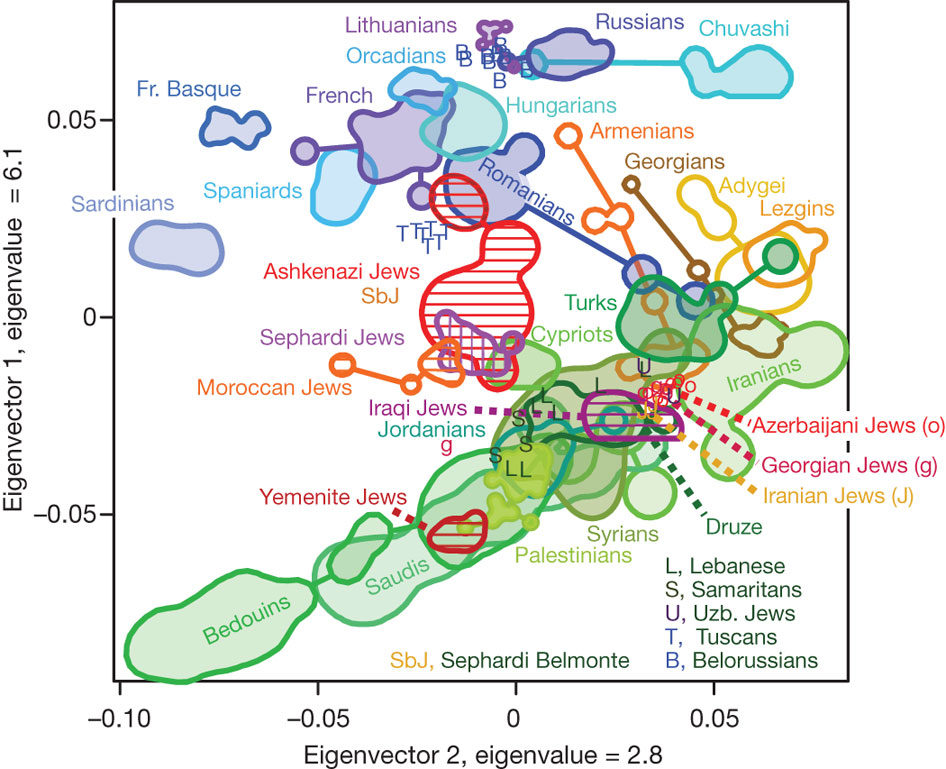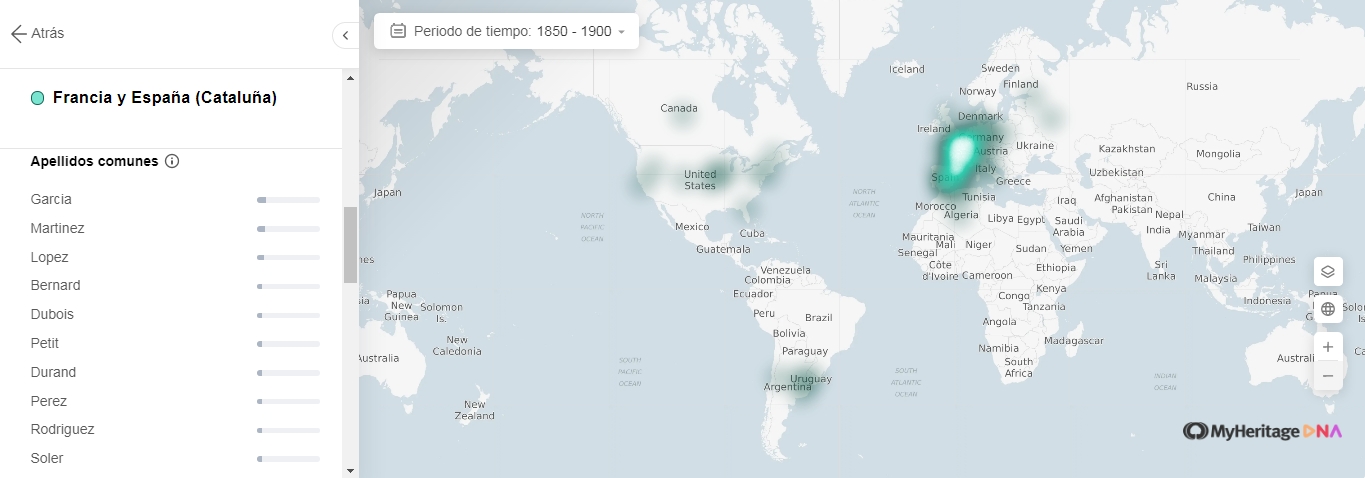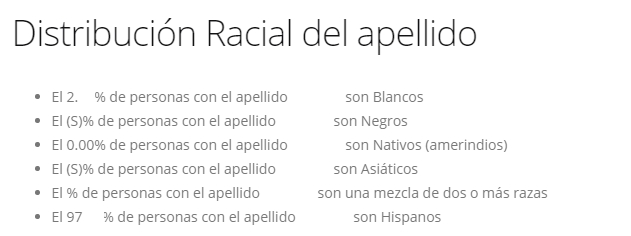Install the app
How to install the app on iOS
Follow along with the video below to see how to install our site as a web app on your home screen.

Note: This feature currently requires accessing the site using the built-in Safari browser.
You are using an out of date browser. It may not display this or other websites correctly.
You should upgrade or use an alternative browser.
You should upgrade or use an alternative browser.
MyHeritageDNA New MyHeritage update (groups)
- Thread starter Variel
- Start date
Carlos
Banned
- Messages
- 2,647
- Reaction score
- 700
- Points
- 0
- Y-DNA haplogroup
- E-V22/YF66572
- mtDNA haplogroup
- J1c5c1
Perhaps in all this period they have already become Maghrebi Jews, otherwise they would have had to exercise a strong inbreeding and would have presented multiple diseases like the Jews of Mallorca. Perhaps the Muslim power has been permissive in the transit of Berber marriages to Sephardic Jews.
Then they changed it I guess. Regardless, the Ashkenazim have no IBD sharing with either Spaniards or Italians.
Hi Angela. Happy New Year
MH's proposal is to establish clusters with modern populations. The Sephardim arrived in Iberia from North Africa and when they were expelled in the late 1400s, they returned mostly there. The Ashkenazins had a strong presence in Central and Eastern Europe until the Holocaust. Before the war, the Ashkenazi corresponded to more than 10,000,000 people. This is more than the current population of Portugal. Israel is a state that emerged in 1945. IMO, it makes no sense to associate the Jews Asquenaze and Sephardi with such a new state, but with their last known origins, which is Central Europe and North Africa, respectively. The Sefardi community in Iberia is numerically insignificant today and many of those who are there today are Sephardic cultural people from Latim America who used complicated bureaucratic intricacies to receive Portuguese or Spanish citizenship and settle in those countries. Concretely, these individuals are neither. They are not ethnic Iberians, nor are they ethnic Jews. The attribution of nationality does not mean attribution of ethnicity and in this sense it is not worthwhile that they participate in statistics or references of ethnicity, mainly in Portugal and Spain, under the risk of distorting the statistical data of the modern Jewish population.
Cheers.
Jovialis
Advisor
- Messages
- 9,313
- Reaction score
- 5,876
- Points
- 113
- Ethnic group
- Italian
- Y-DNA haplogroup
- R-PF7566 (R-Y227216)
- mtDNA haplogroup
- H6a1b7
Romanians have strong Balkan and Roman influences, also strong Slavic ones and minor, but significant, more recent ones from various steppe people, Hungarians, Germans, Serbs and Bulgarians among others. Its in any case about more recent common ancestry than the Bronze Age with this feature, so admixture within historical times. The question is just in which direction it was going, from Romania or to Romania. Could be the general Vlach/Balkan cluster via Albanian ancestry?
I get French in Northern America on low confidence because some German-French relatives of ancestors moved to these communities.
I think it may be far fetched that this is an indication, but some speculate that the Apuli may have originated in Dacia.
Jovialis
Advisor
- Messages
- 9,313
- Reaction score
- 5,876
- Points
- 113
- Ethnic group
- Italian
- Y-DNA haplogroup
- R-PF7566 (R-Y227216)
- mtDNA haplogroup
- H6a1b7
The Apuli or Biefi were a Dacian tribe centered at the Dacian town Apulon (Latin Apulum) near what is now Alba Iulia in Transylvania, Romania.
Apuli has clear resemblance to Apulia, the ancient southeastern Italy region, which is believed to have been settled by Illyrian tribes (also named Apuli or Iapyges).
Linguists use it as an example for the similarities between Illyrian and Dacian language.[1]
https://en.wikipedia.org/wiki/Apuli

https://en.wikipedia.org/wiki/Dacia#/media/File:Dacia_82_BC.png
Jovialis
Advisor
- Messages
- 9,313
- Reaction score
- 5,876
- Points
- 113
- Ethnic group
- Italian
- Y-DNA haplogroup
- R-PF7566 (R-Y227216)
- mtDNA haplogroup
- H6a1b7
I think it may be far fetched that this is an indication, but some speculate that the Apuli may have originated in Dacia.
Though perhaps not too far fetched. I don't know of any Apuli samples, but I am fairly close to the Iron Age Bulgarian sample:
| Distance to: | Jovialis |
|---|---|
| 8.92001682 | Balkans_IronAge:I5769_Bulgaria_IA |
Angela
Elite member
- Messages
- 21,823
- Reaction score
- 12,329
- Points
- 113
- Ethnic group
- Italian
Perhaps in all this period they have already become Maghrebi Jews, otherwise they would have had to exercise a strong inbreeding and would have presented multiple diseases like the Jews of Mallorca. Perhaps the Muslim power has been permissive in the transit of Berber marriages to Sephardic Jews.
We have their autosomal analysis, Carlos.

You'll find a lot of nonsense on the net from the pre-genetic analysis days, but we now know a lot more.
"The study carried out by Behar et al. that analysed small samples of North African Jews (Libya (83); Morocco (149); Tunisia (37)) indicates that Jews from North Africa lack typically North African Hg M1 and U6 mtDNAs.[13] Hence, according to the authors, the lack of U6 and M1 haplogroups among the North Africans renders the possibility of significant admixture, as between the local Arab and Berber populations with Jews, unlikely. The genetic evidence shows them to be distinct from Berber populations, but more similar to Ashkenazi Jewish populations.[13]"
https://en.wikipedia.org/wiki/Berber_Jews
Most of their ancestry is from the expelled Jews of Spain.
"Analysis of mitochondrial DNA of the Jewish populations of North Africa (Morocco, Tunisia, Libya) was the subject of further detailed study in 2008 by Doron Behar et al.[40] The analysis concludes that Jews from this region do not share the haplogroups of the mitochondrial DNA haplogroups (M1 and U6) that are typical of the North African Berber and Arab populations. Similarly, while the frequency of haplogroups L, associated with sub-Saharan Africa, are present in approximately 20–25% at the Berber populations studied, these haplogroups are only present in 1.3%, 2.7% and 3.6% respectively of Jews from Morocco, Tunisia and Libya.[40]Behar et al. conclude that it is unlikely that North African Jews have significant Arab, or Berber admixture, "consistent with social restrictions imposed by religious restrictions," or endogamy. This study also found genetic similarities between the Ashkenazi and North African Jews of European mitochondrial DNA pools, but differences between both of these of the diaspora and Jews from the Middle East.[40]
Salento
Regular Member
- Messages
- 5,635
- Reaction score
- 2,838
- Points
- 113
- Ethnic group
- Italian
- Y-DNA haplogroup
- T1a2 - SK1480
- mtDNA haplogroup
- H12a
... mineThough perhaps not too far fetched. I don't know of any Apuli samples, but I am fairly close to the Iron Age Bulgarian sample:
Distance to: Jovialis 8.92001682 Balkans_IronAge:I5769_Bulgaria_IA
| Distance to: | S_23v5_dod13 |
|---|
| 9.50521436 | _Bulgaria_IA_:I5769 |

| Distance to: | S_Comb_dodK13 |
|---|
| 9.56978579 | _Bulgaria_IA_:I5769 |
Carlos
Banned
- Messages
- 2,647
- Reaction score
- 700
- Points
- 0
- Y-DNA haplogroup
- E-V22/YF66572
- mtDNA haplogroup
- J1c5c1
We have their autosomal analysis, Carlos.

You'll find a lot of nonsense on the net from the pre-genetic analysis days, but we now know a lot more.
"The study carried out by Behar et al. that analysed small samples of North African Jews (Libya (83); Morocco (149); Tunisia (37)) indicates that Jews from North Africa lack typically North African Hg M1 and U6 mtDNAs.[13] Hence, according to the authors, the lack of U6 and M1 haplogroups among the North Africans renders the possibility of significant admixture, as between the local Arab and Berber populations with Jews, unlikely. The genetic evidence shows them to be distinct from Berber populations, but more similar to Ashkenazi Jewish populations.[13]"
https://en.wikipedia.org/wiki/Berber_Jews
Most of their ancestry is from the expelled Jews of Spain.
"Analysis of mitochondrial DNA of the Jewish populations of North Africa (Morocco, Tunisia, Libya) was the subject of further detailed study in 2008 by Doron Behar et al.[40] The analysis concludes that Jews from this region do not share the haplogroups of the mitochondrial DNA haplogroups (M1 and U6) that are typical of the North African Berber and Arab populations. Similarly, while the frequency of haplogroups L, associated with sub-Saharan Africa, are present in approximately 20–25% at the Berber populations studied, these haplogroups are only present in 1.3%, 2.7% and 3.6% respectively of Jews from Morocco, Tunisia and Libya.[40]Behar et al. conclude that it is unlikely that North African Jews have significant Arab, or Berber admixture, "consistent with social restrictions imposed by religious restrictions," or endogamy. This study also found genetic similarities between the Ashkenazi and North African Jews of European mitochondrial DNA pools, but differences between both of these of the diaspora and Jews from the Middle East.[40]
Since 1990, several genetic studies of Jewish populations have been conducted
https://es.wikipedia.org/wiki/Judíos_bereberes
We see other studies from 2008, 2013 and until 2021 it has rained.
I understand that it may be hard to let go of what was taken for granted based on studies from 10 or 20 years ago or maybe more, but these days we are seeing how other genetic studies for other subjects from 10, 20 years ago are turning into wet paper.
torzio
Regular Member
- Messages
- 3,973
- Reaction score
- 1,236
- Points
- 113
- Location
- Eastern Australia
- Ethnic group
- North East Italian
- Y-DNA haplogroup
- T1a2 - SK1480
- mtDNA haplogroup
- H95a
If you check all italian papers , be them old or newer ones....they all state the Apuli are the same as the Liburnians ....either a sub branch or related
https://books.google.com.au/books?i...HoECAEQAg#v=onepage&q=apuli e liburni&f=false
it comes to being , when the Liburnians landed in Picene ( marche ) in circa 1000BC, the Iapygian tribes that inhabited Apulia during the first millennium BC – the Daunians in the North, the Peucetians in the Centre, as well as the Messapians in the South.[7][8]
at the same time
..........................................................
III Veneti, Piceni e Apuli: una “Magna Illyria”? pag. 14 3 ... La Krka li divideva dai Liburni che originariamente abitavano la Dalmazia settentrionale, a settentrione ...
from a new author /scholar
[h=1]POPOLI, PAESI E CITTA’ DEL MEDITERRANEO di EMILIO BENVENUTO[/h] by rosaria.pullo
https://en.calameo.com/read/000150262f61a760a117a
Salento
Regular Member
- Messages
- 5,635
- Reaction score
- 2,838
- Points
- 113
- Ethnic group
- Italian
- Y-DNA haplogroup
- T1a2 - SK1480
- mtDNA haplogroup
- H12a
If you check all italian papers , be them old or newer ones....they all state the Apuli are the same as the Liburnians ....either a sub branch or related
https://books.google.com.au/books?i...HoECAEQAg#v=onepage&q=apuli e liburni&f=false
it comes to being , when the Liburnians landed in Picene ( marche ) in circa 1000BC, the Iapygian tribes that inhabited Apulia during the first millennium BC – the Daunians in the North, the Peucetians in the Centre, as well as the Messapians in the South.[7][8]
at the same time
..........................................................
III Veneti, Piceni e Apuli: una “Magna Illyria”? pag. 14 3 ... La Krka li divideva dai Liburni che originariamente abitavano la Dalmazia settentrionale, a settentrione ...
from a new author /scholar
POPOLI, PAESI E CITTA’ DEL MEDITERRANEO di EMILIO BENVENUTO
by rosaria.pullo
https://en.calameo.com/read/000150262f61a760a117a
... as of now only 3 MTA members get this, ...
... I posted an older lower deep dive rank before, but went up and has been steady for a while, ... :


and I3313 could be related to I5769


torzio
Regular Member
- Messages
- 3,973
- Reaction score
- 1,236
- Points
- 113
- Location
- Eastern Australia
- Ethnic group
- North East Italian
- Y-DNA haplogroup
- T1a2 - SK1480
- mtDNA haplogroup
- H95a
... as of now only 3 MTA members get this, ...
... I posted an older lower deep dive rank before, but went up and has been steady for a while, ... :


and I3313 could be related to I5769


Do I win ?!
5. Illyrian / Dalmatian
1200 BC - Genetic Distance: 8.937 - I3313
Top 99 % match vs all users
..........................................
i am waiting for the 32 samples to be analyzed from this site
http://isaw.nyu.edu:8080/isaw/library/blog/croatian-excavation-loewen
torzio
Regular Member
- Messages
- 3,973
- Reaction score
- 1,236
- Points
- 113
- Location
- Eastern Australia
- Ethnic group
- North East Italian
- Y-DNA haplogroup
- T1a2 - SK1480
- mtDNA haplogroup
- H95a
@ salento
https://www.youtube.com/watch?v=fxw5l6-1GOE
An Umbrian-Sabellic people born from the fusion of different elements, including the mysterious Liburnian people of the eastern shore of the Adriatic, the Picenians for a long time played a fundamental role in the development of the cultures of Central Italy,
https://www.youtube.com/watch?v=fxw5l6-1GOE
An Umbrian-Sabellic people born from the fusion of different elements, including the mysterious Liburnian people of the eastern shore of the Adriatic, the Picenians for a long time played a fundamental role in the development of the cultures of Central Italy,
Salento
Regular Member
- Messages
- 5,635
- Reaction score
- 2,838
- Points
- 113
- Ethnic group
- Italian
- Y-DNA haplogroup
- T1a2 - SK1480
- mtDNA haplogroup
- H12a
@ salento
https://www.youtube.com/watch?v=fxw5l6-1GOE
An Umbrian-Sabellic people born from the fusion of different elements, including the mysterious Liburnian people of the eastern shore of the Adriatic, the Picenians for a long time played a fundamental role in the development of the cultures of Central Italy,
1600s Marche (Picenians area) and Rome are also part of Lecce (Salento) genetic group:

... you win the “Matching Samples”, but I win the Deep Dive :grin:
kingjohn
Regular Member
- Messages
- 2,234
- Reaction score
- 1,212
- Points
- 113
The Sephardic ethnicity, according to MyHeritage



nice :cool-v:
contrary to ftdna my origins 3.0
where the sefhardic refernce is based on turkish sefhardi and greek sefhardi
Carlos
Banned
- Messages
- 2,647
- Reaction score
- 700
- Points
- 0
- Y-DNA haplogroup
- E-V22/YF66572
- mtDNA haplogroup
- J1c5c1
Carlos' multidisciplinary studies



In these two maps are the ones that give me Northwest European In these two maps are the ones that give me Northwest European in common ethnicities

With my situation in Y full
The distribution of the surname in Malaga province where my most remote ancestor would have originated

Only 18 inhabitants have it as their first surname and 26 as their second surname

The surname is held by 2% of whites and 97% of Hispanics referring to Hispanic Americans.
These percentages in the surname for the dna Y speak to me of a non-native of Spain, a native would have the highest percentage
Genetic results with photographic input which is something you rarely get the chance to do. Although I'm not too good at sorting
DNA lineage and from great-grandfather to father:

Paternal great-grandfather

Paternal grandfather

Parent



In these two maps are the ones that give me Northwest European In these two maps are the ones that give me Northwest European in common ethnicities

With my situation in Y full
The distribution of the surname in Malaga province where my most remote ancestor would have originated

Only 18 inhabitants have it as their first surname and 26 as their second surname

The surname is held by 2% of whites and 97% of Hispanics referring to Hispanic Americans.
These percentages in the surname for the dna Y speak to me of a non-native of Spain, a native would have the highest percentage
Genetic results with photographic input which is something you rarely get the chance to do. Although I'm not too good at sorting
DNA lineage and from great-grandfather to father:

Paternal great-grandfather

Paternal grandfather

Parent
Romanians have strong Balkan and Roman influences, also strong Slavic ones and minor, but significant, more recent ones from various steppe people, Hungarians, Germans, Serbs and Bulgarians among others. Its in any case about more recent common ancestry than the Bronze Age with this feature, so admixture within historical times. The question is just in which direction it was going, from Romania or to Romania. Could be the general Vlach/Balkan cluster via Albanian ancestry?
Maybe genetic groups are not ancient but are based on recent times, as they are based on our matches.
I think the correct genetic groups for Apulians is another balkan population, perhaps the Dalmatian coast or the interior. On Ftdna, 23andme and Myheritage I have many balkan matches of Croatia, Bosnia Herzegovnia, Serbia.. I have some documented ancestors from 1500/1600s of Dubrovnik.
This thread has been viewed 60420 times.




